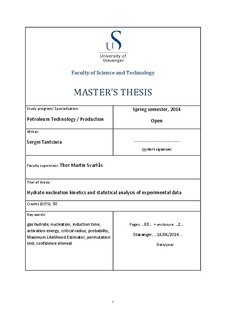| dc.contributor.author | Tantciura, Sergei | |
| dc.date.accessioned | 2014-09-22T13:32:18Z | |
| dc.date.available | 2014-09-22T13:32:18Z | |
| dc.date.issued | 2014-06-16 | |
| dc.identifier.uri | http://hdl.handle.net/11250/220967 | |
| dc.description | Master thesis in Petroleum engineering | nb_NO |
| dc.description.abstract | The effect on accuracy of reducing the number of experiments in the series has been investigated on isochoric, constant temperature nucleation experiments. In addition, data from two other nucleation studies have been analyzed.
The experiments were conducted in two autoclave high pressure cells with similar construction but different overall dimensions. Two different gas mixtures were used: SNG-2 and SNG-7. Experimental conditions such as pressure (90 bar) and cooling rate (6.0 C/h) were kept constant for all the experiments. Three experimental series at different temperatures have been conducted on each cell, which allowed estimation of activation energy of gas hydrate nucleation by means of the Arrhenius equation through the Arrhenius plot. The radius of the critical size nuclei was determined once the activation energy was estimated.
Two different techniques were utilized in order to estimate nucleation rate of hydrate nucleation, namely a best-fit method included in the graphical program tool KaleidaGraph and penalized Maximum Likelihood Estimation (MLE) for two-parameter exponential distribution.
Two maximum deviation levels of 20 % and 30 % from estimated value obtained with the maximum number of parallels included were set as test criteria evaluating the minimum number of parallels required to determine particular parameter.
Based on the results of statistical analysis of the experimental data in the present study the minimum number of experiments to obtain a representative value of nucleation rate estimate can be proposed to be not less than several tens to provide accuracy within 20-30 %. To make some conclusions about the exact number, analysis of a series with more parallels is required.
For the conducted experiments acceptable accuracies were obtained for estimation of nuclei size even though the number of parallels was reduced to 6 for the large cell experiments. However, there was not found clear relationship between number of parallels and fit of Ln J as function of 1/T to a straight line.
The set accuracy limit that determines maximum acceptable deviation in a parameter estimate showed great influence on the required number of parallels. | nb_NO |
| dc.language.iso | eng | nb_NO |
| dc.publisher | University of Stavanger, Norway | nb_NO |
| dc.rights | Attribution 3.0 Norway | * |
| dc.rights.uri | http://creativecommons.org/licenses/by/3.0/no/ | * |
| dc.subject | petroleumsteknologi | nb_NO |
| dc.subject | gas hydrate | nb_NO |
| dc.subject | produksjonsteknologi | nb_NO |
| dc.subject | induction time | nb_NO |
| dc.title | Hydrate nucleation kinetics and statistical analysis of experimental data | nb_NO |
| dc.type | Master thesis | nb_NO |
| dc.subject.nsi | VDP::Technology: 500::Rock and petroleum disciplines: 510::Petroleum engineering: 512 | nb_NO |

